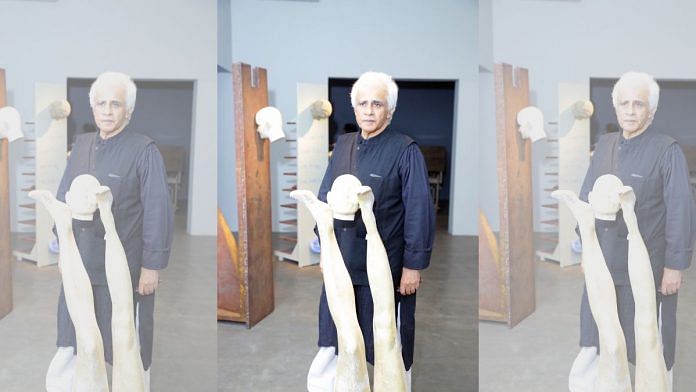An excerpted translation of one of Rumi’s poems goes something like this: “Anything you lose comes round in another form.” But grief is inevitable when a great loss announces itself. The loss of Vivan Sundaram cuts deep for all of us.
Vivan Sundaram was a preeminent Indian artist who had a larger-than-life influence on the community, history and global trajectory of Indian art. In the most important of ways, Vivan was a pioneering conceptual artist we saw grow out of India. He was committed to exploring and establishing a radical, interdisciplinary practice, with his intellectual bent of mind, a rigorous understanding of aesthetics and politics, and an expansive knowledge of art from around the world. Vivan built his theatre of art around the avant-garde spirit, using a diverse array of painting, sculpture, printmaking, photography, installation and video art to pursue socially active and reactive undertakings on the poetry and politics of identity. The works he leaves behind startle, stun, overwhelm and overcome; they continue the legacy of their maker, of opening up spaces and minds.
The two familiar faces
Our relationship with Vivan and his wife, the esteemed art historian Geeta Kapur, is has been one of warmth and friendship. It always touched us to witness their involvement and interest in the ongoing exhibitions and engaging with artists.
As a couple, they offered us all a nurturing presence. Awaiting Vivan’s feedback, which he delivered with an ethereal charm, was always a memorable exercise. He devoted much of his time to mentoring younger artists and remains among the most well-respected and adored contemporaries of our time.
At the gallery, we’ve had the distinct pleasure of presenting Vivan’s works to the public on several occasions. In 2013, Vivan did a solo exhibition with us titled Postmortem (After Gagawaka), where we together highlighted the sheer scale, diversity of media and endearing eccentricity of his practice. He transformed the gallery with his vision, creating a uniquely immersive environment that we still fondly recall. I have always admired the scale of his works and the ingenuity with which he created Vivan-centric overlaps between genres of ideas and the tactility of materials.
During the gallery’s 25th anniversary exhibition at Lalit Kala Akademi, we grandly presented one of Vivan’s video works in a floor projection. More recently, at India Art Fair 2023 we were able to show an important series of work that grew out of Vivan’s persistent illness and meditated on the body as a site of regeneration and repair. An expanded suite of these works went on to be exhibited at the ongoing Sharjah Biennale, which Vivan was so very excited about. The immense scale at which Vivan composed his works remains a rare and enigmatic feat. It was especially wonderful to see a major body of work on view at his retrospective exhibition at the Kiran Nadar Museum of Art, New Delhi, in 2018 and to interact with the enormity and spatial–structural interventions of his constructions. It is no mystery why Vivan has received a great deal of valuable attention from institutions. In April, the Tate Modern in London will be presenting his iconic room-size installation – Memorial.
Also read: Upma with chicken stock, bacon pulao — Floyd Cardoz was godfather of modern Indian cuisine
The ceaseless influence
Vivan’s epic and colossal personality was not only enveloping in the embrace he offered us at the gallery in terms of supporting our artists and programmes across the board but also in the vision and insight he offered the Foundation of Indian Contemporary Art (FICA).Their commitment to nourishing the next generation of artists and cultivating a vibrant and growth-oriented environment in the arts also motivated the setting of Sher-Gil Sundaram Arts Foundation in 2016.
Vivan’s monumental contributions to the world of art in general and Indian art in particular are remarkable but perhaps an even greater source of celebration is the deeply personal nature of his impact. Today we individually and collectively mourn the loss of a thinker, a teacher, a relative, a friend, an activist and a creator. Vivan’s experiments with scale were not limited to his art. He transcended the mediums he worked in to give us all a part of himself, which we use to carry on.
Arun Vadehra is Director, Vadehra Art Gallery. Views are personal.
(Edited by Anurag Chaubey)



